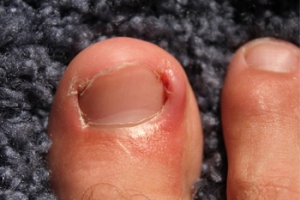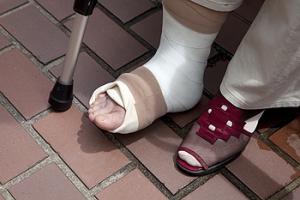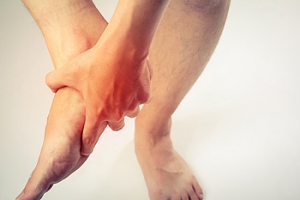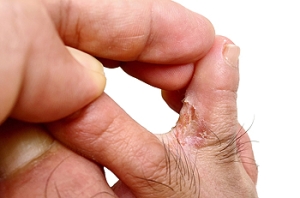

Are Ingrown Toenails Painful?
 Increased pressure of a toenail that grows into the surrounding skin is often referred to as an ingrown toenail. This condition can often produce severe discomfort and pain as a result of inflammation that may occur. If this ailment is left untreated, infections can occur, which may lead to additional unwanted foot conditions. Typical reasons why ingrown toenails can develop, may include having a pedicure performed incorrectly, traits from inherited genes, or shoes that do not fit correctly. Medical conditions such as obesity, diabetes, bunions, or hammertoes may play a significant role in developing this painful condition. If you are afflicted with an ingrown toenail, it’s advised to seek a consultation with a podiatrist as quickly as possible to learn about correct treatment options.
Increased pressure of a toenail that grows into the surrounding skin is often referred to as an ingrown toenail. This condition can often produce severe discomfort and pain as a result of inflammation that may occur. If this ailment is left untreated, infections can occur, which may lead to additional unwanted foot conditions. Typical reasons why ingrown toenails can develop, may include having a pedicure performed incorrectly, traits from inherited genes, or shoes that do not fit correctly. Medical conditions such as obesity, diabetes, bunions, or hammertoes may play a significant role in developing this painful condition. If you are afflicted with an ingrown toenail, it’s advised to seek a consultation with a podiatrist as quickly as possible to learn about correct treatment options.
Ingrown toenails can become painful if they are not treated properly. For more information about ingrown toenails, contact Dr. Randy Garr of Bigfoot Podiatry. Our doctor can provide the care you need to keep you pain-free and on your feet.
Ingrown Toenails
Ingrown toenails occur when a toenail grows sideways into the bed of the nail, causing pain, swelling, and possibly infection.
Causes
- Bacterial infections
- Improper nail cutting such as cutting it too short or not straight across
- Trauma to the toe, such as stubbing, which causes the nail to grow back irregularly
- Ill-fitting shoes that bunch the toes too close together
- Genetic predisposition
Prevention
Because ingrown toenails are not something found outside of shoe-wearing cultures, going barefoot as often as possible will decrease the likeliness of developing ingrown toenails. Wearing proper fitting shoes and using proper cutting techniques will also help decrease your risk of developing ingrown toenails.
Treatment
Ingrown toenails are a very treatable foot condition. In minor cases, soaking the affected area in salt or antibacterial soaps will not only help with the ingrown nail itself, but also help prevent any infections from occurring. In more severe cases, surgery is an option. In either case, speaking to your podiatrist about this condition will help you get a better understanding of specific treatment options that are right for you.
If you have any questions please feel free to contact our office located in Provo, UT . We offer the newest diagnostic and treatment technologies for all your foot and ankle needs.
Ingrown Toenail Care
An ingrown toenail is a toenail that grows sideways into the nail bed, causing pain and swelling. Ingrown toenails can worsen and cause drainage, turning into a serious infection.
Several factors affect whether a person is at risk from an ingrown toenail. The many causes include being overweight, diabetes, participating in sports, having a fungal infection of the toe, and cutting your nails too short. Ingrown toenails also have a genetic predisposition, causing some people to be more prone to receive the condition than others. Other causes include improperly fitting shoes and shoes that keep the feet damp.
Ingrown toenails can be preventable with certain measures. For starters, allowing your toe nails to grow slightly longer in length will help prevent them from becoming ingrown. If you have already developed an ingrown toenail, soak the affected toe in warm water. This will alleviate the pain and help prevent an infection from forming. Antibiotic soap or Epsom salts may be added to further help the relieving process and avoid infection. Placing cotton beneath the affected area is also suggested, as this may help the toenail grow upwards and not into the nail bed. Swelling and redness can be reduced by resting with your feet elevated.
A podiatrist should be seen if the pain becomes so serious that it prevents you from doing your everyday activities. If a red streak running up your leg appears or if you suspect your infection has spread, contact a podiatrist immediately. Fast treatments can be undertaken to lessen your pain and have you walking comfortably.
An ingrown toenail can be easily treated with a Band-Aid. Simply wrap the affected toe with a Band-Aid to prevent infection and keep the nail from growing out at a painful angle.
In more serious cases, your podiatrist may decide to make a small incision to remove a portion of your toenail. To prevent the nail from growing back, medication will be placed directly into the nail bed. This procedure would be performed under local anesthesia and is a faster method to alleviate discomfort from an ingrown toenail. Post-procedure directions will have you stay off the affected foot for a day. Afterwards, normal activities can be resumed.
Why Should Children’s Feet Be Measured Frequently?
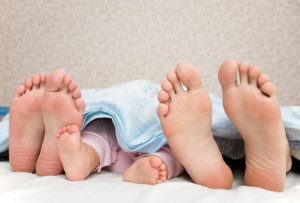 Recent research has shown the importance of children walking barefoot or wearing shoes that have a soft sole when they are beginning to walk. This will enable the development of necessary muscle strength in addition to learning sensory information that originates from the soles of the feet. The feet should be properly measured once walking commences, to ensure a proper fit for shoes. Children’s feet grow rapidly, and frequent measuring of the feet will aid in choosing shoes that fit correctly. Foot conditions may develop as a result of poorly fitting shoes. These may include ingrown toenails, blisters, or the inability to walk correctly. When shopping for shoes, it’s important for the toes to have adequate room to move around and the front of the shoe should be wider than the heel. Most children are born with flat feet and arches will form when walking begins. Please consult with a podiatrist if your child appears to be flat-footed once walking has started.
Recent research has shown the importance of children walking barefoot or wearing shoes that have a soft sole when they are beginning to walk. This will enable the development of necessary muscle strength in addition to learning sensory information that originates from the soles of the feet. The feet should be properly measured once walking commences, to ensure a proper fit for shoes. Children’s feet grow rapidly, and frequent measuring of the feet will aid in choosing shoes that fit correctly. Foot conditions may develop as a result of poorly fitting shoes. These may include ingrown toenails, blisters, or the inability to walk correctly. When shopping for shoes, it’s important for the toes to have adequate room to move around and the front of the shoe should be wider than the heel. Most children are born with flat feet and arches will form when walking begins. Please consult with a podiatrist if your child appears to be flat-footed once walking has started.
The health of a child’s feet is vital to their overall well-being. If you have any questions regarding foot health, contact Dr. Randy Garr of Bigfoot Podiatry. Our doctor can provide the care you need to keep you pain-free and on your feet.
Tips for Keeping Children's Feet Healthy
- Make sure their shoes fit properly
- Look for any signs of in-toeing or out-toeing
- Check to see if they have Clubfoot (condition that affects your child’s foot and ankle, twisting the heel and toes inward) which is one of the most common nonmajor birth defects.
- Lightly cover your baby’s feet (Tight covers may keep your baby from moving their feet freely, and could prevent normal development)
- Allow your toddler to go shoeless (Shoes can be restricting for a young child’s foot)
- Cut toenails straight across to avoid ingrown toenails
- Keep your child’s foot clean and dry
- Cover cuts and scrapes. Wash any scratches with soap and water and cover them with a bandage until they’ve healed.
If you have any questions, please feel free to contact our office located in Provo, UT . We offer the newest diagnostic and treatment technologies for all your foot care needs.
What to Do to Keep Your Child’s Feet Healthy
Being a parent involves caring for your child in every way you can. You make sure they are eating the right food, being nice to others, and staying out of any trouble. However, it is also important that you are watchful of their health, more specifically their foot health. Maintaining good foot health in childhood is important in preventing later conditions in life from happening. As children continue to develop, their feet require different techniques of care. Here are some various ways in which you can help your child’s feet stay healthy.
A baby needs a lot of care and attention overall, but the importance of their feet should never be forgotten. Before a baby turns one, their feet change and develop greatly. It is important that during this time, a mother avoids putting tight socks on their child. She should also encourage movement of their feet so the baby can begin to feel more comfortable using them.
As a baby enters the toddler years of his or her life, they are begin to walk around. When your baby begins to take those first steps, it is crucial that they are wearing protective shoes on their feet. As a mother that is observant of your child’s feet, you may notice changes in them. This is completely normal as the feet are becoming susceptible to the activity of walking. It is normal for a toddler to be a bit unsteady or to “walk funny” at first.
When your child grows out of their toddler years, it is important that you begin to show him or her how to care for their feet on their own. Practice with your child proper hygiene in order to prevent foot fungus or infection. Since children are constantly on the move, it is crucial to be cautious of any accidents or injuries that might occur. If an injury occurs, it is advised that you take your child to be examined by a doctor immediately. Since your child is still growing, particular injuries can shift the way in which a bone or other important part of the foot is developing.
Babies and kids are always changing and growing. Your job as a parent is to make sure they stay healthy and making sure they are properly maintained. This involves proper foot care and making sure the feet stay healthy. Following this guide, your child can live a long and happy life.
Have I Broken My Ankle?
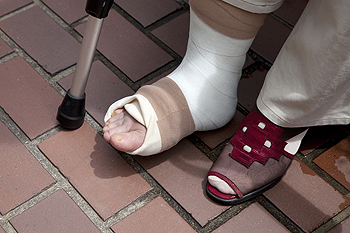 If you have suffered a traumatic ankle injury that may result in swelling, severe pain and bruising, you may have broken your ankle. Most broken ankles occur from a fall, which causes one or more of the ankle bones to fracture. Occasionally, if jumping from an extended height occurs, the joints may undergo extreme flexing, which may cause a broken ankle. It’s important to take all weight off the ankle as soon as possible, and this is typically accomplished by immobilizing the ankle in a cast. Research has shown that six weeks is the average time a cast is worn, which typically allows ample time for the ankle bone to heal. For severe breaks, surgery may be necessary to adequately repair the bone, which may include inserting metal pins or plates. It’s beneficial to begin a rehabilitation program when the cast is removed. This may ensure proper mobility. Please speak to a podiatrist if you have broken your ankle for additional information.
If you have suffered a traumatic ankle injury that may result in swelling, severe pain and bruising, you may have broken your ankle. Most broken ankles occur from a fall, which causes one or more of the ankle bones to fracture. Occasionally, if jumping from an extended height occurs, the joints may undergo extreme flexing, which may cause a broken ankle. It’s important to take all weight off the ankle as soon as possible, and this is typically accomplished by immobilizing the ankle in a cast. Research has shown that six weeks is the average time a cast is worn, which typically allows ample time for the ankle bone to heal. For severe breaks, surgery may be necessary to adequately repair the bone, which may include inserting metal pins or plates. It’s beneficial to begin a rehabilitation program when the cast is removed. This may ensure proper mobility. Please speak to a podiatrist if you have broken your ankle for additional information.
Broken ankles need immediate treatment. If you are seeking treatment, contact Dr. Randy Garr from Bigfoot Podiatry. Our doctor can provide the care you need to keep you pain-free and on your feet.
Broken Ankles
A broken ankle is experienced when a person fractures their tibia or fibula in the lower leg and ankle area. Both of these bones are attached at the bottom of the leg and combine to form what we know to be our ankle.
When a physician is referring to a break of the ankle, he or she is usually referring to a break in the area where the tibia and fibula are joined to create our ankle joint. Ankles are more prone to fractures because the ankle is an area that suffers a lot of pressure and stress. There are some obvious signs when a person experiences a fractured ankle, and the following symptoms may be present.
Symptoms of a Fractured Ankle
- Excessive pain when the area is touched or when any pressure is placed on the ankle
- Swelling around the area
- Bruising of the area
- Area appears to be deformed
If you suspect an ankle fracture, it is recommended to seek treatment as soon as possible. The sooner you have your podiatrist diagnose the fracture, the quicker you’ll be on the way towards recovery.
If you have any questions, please feel free to contact our office located in Provo, UT . We offer the newest diagnostic and treatment technologies for all your foot care needs.
All About Broken Ankles
Broken ankles are a serious injury that can lead to an inability to walk, function, and also cause a significant amount of pain. A broken ankle is a break in one of the three bones in your body that connect at the ankle joint: the tibia, the fibula, and the talus. The tibia and fibula are your two primary leg bones that connect at the knee, which sit directly upon the talus bone. This is protected by a fibrous membrane that allows for movement in the ankle joint. A broken ankle is usually caused by the foot rolling under or twisting too far, causing one of these three bones to snap.
A broken ankle is different from an ankle sprain, which occurs when the ankle ligaments are ripped or torn but no bones have been broken. A sprain can still be very severe, causing bruising in the foot and an inability to hold your own weight, much like a broken ankle would. If you’re unable to stand, and suspect that you have a broken ankle, the first thing to do would be to get an immediate X-ray to determine the severity of the break.
A common cause of broken ankles is when the ankle is rolled over with enough pressure to break the bones. This usually happens during exercise, sports, or other physical activity. Another common cause is a fall or jump from a tall height.
One immediate treatment for pain relief is elevating the foot above your head to reduce blood flow to the injured area. You can also apply ice packs to your ankle to help reduce swelling, redness, inflammation, and pain. After these initial steps, getting a cast and staying off your feet as much as possible will aid in the recovery of the broken ankle. The less movement and stress the ankle has to endure, the more complete it will heal. A doctor can determine if surgery is needed in order to heal correctly. In these cases, an operation may be the only option to ensure the ability to walk properly again, followed by physical therapy and rehabilitation.
It is highly important to determine if surgery is needed early on, because a broken ankle can become much more severe than you realize. If not professionally treated, the broken ankle will inhibit your walking, daily functioning, and produce a large amount of pain. Treating your broken ankle early on will help prevent further damage to it.
Several Common Types of Foot Pain
 There are several foot conditions that may produce considerable pain. Fractures, sprains and Achilles tendon injuries may all be among common foot ailments that fall into this category. Stiffness may be a result of tendinitis in the foot, and relief may be found by consulting with a podiatrist for proper treatment options. A type of arthritis referred to as gout is known to cause severe pain at the bottom of the big toe and surrounding areas. It is a result of excess crystals that form in the bloodstream due to a large amount of uric acid in the blood. Foods that are rich in purines such as shellfish and red meat may contribute to the onset of gout. Other causes of foot pain may include plantar fasciitis, uncontrolled diabetes, or Morton’s neuroma. A podiatrist will be able to determine the specific cause of certain foot pain, and it’s suggested to seek counsel as soon as possible.
There are several foot conditions that may produce considerable pain. Fractures, sprains and Achilles tendon injuries may all be among common foot ailments that fall into this category. Stiffness may be a result of tendinitis in the foot, and relief may be found by consulting with a podiatrist for proper treatment options. A type of arthritis referred to as gout is known to cause severe pain at the bottom of the big toe and surrounding areas. It is a result of excess crystals that form in the bloodstream due to a large amount of uric acid in the blood. Foods that are rich in purines such as shellfish and red meat may contribute to the onset of gout. Other causes of foot pain may include plantar fasciitis, uncontrolled diabetes, or Morton’s neuroma. A podiatrist will be able to determine the specific cause of certain foot pain, and it’s suggested to seek counsel as soon as possible.
Foot Pain
Foot pain can be extremely painful and debilitating. If you have a foot pain, consult with Dr. Randy Garr from Bigfoot Podiatry. Our doctor will assess your condition and provide you with quality foot and ankle treatment.
Causes
Foot pain is a very broad condition that could be caused by one or more ailments. The most common include:
- Bunions
- Hammertoes
- Plantar Fasciitis
- Bone Spurs
- Corns
- Tarsal Tunnel Syndrome
- Ingrown Toenails
- Arthritis (such as Gout, Rheumatoid, and Osteoarthritis)
- Flat Feet
- Injury (from stress fractures, broken toe, foot, ankle, Achilles tendon ruptures, and sprains)
- And more
Diagnosis
To figure out the cause of foot pain, podiatrists utilize several different methods. This can range from simple visual inspections and sensation tests to X-rays and MRI scans. Prior medical history, family medical history, and any recent physical traumatic events will all be taken into consideration for a proper diagnosis.
Treatment
Treatment depends upon the cause of the foot pain. Whether it is resting, staying off the foot, or having surgery; podiatrists have a number of treatment options available for foot pain.
If you have any questions, please feel free to contact our office located in Provo, UT . We offer the newest diagnostic and treatment technologies for all your foot care needs.
Foot Pain
The feet, being the foundation of the body, carry all of the body’s weight and are therefore prone to experiencing pain and discomfort. If you are experiencing foot pain, it is important to determine where in the foot you are experiencing this pain to help discover the cause of it. While pain can be experienced virtually anywhere in the foot, the most common sites of foot pain are in the heel and ankle.
Heel pain can be due to a multitude of conditions including plantar fasciitis, Achilles tendinitis, and heel spurs. Pain experienced in the ankle can be a sign of an ankle sprain, arthritis, gout, ankle instability, ankle fracture, or nerve compression. In more serious cases, pain in the foot can be a sign of improper alignment or an infection.
Foot pain can be accompanied by symptoms including redness, swelling, stiffness and warmth in the affected area. Whether the pain can be described as sharp or dull depends on the foot condition behind it. It is important to visit your local podiatrist if your foot pain and its accompanying symptoms persist and do not improve over time.
Depending on the location and condition of your foot pain, your podiatrist may prescribe certain treatments. These treatments can include but are not limited to prescription or over-the-counter drugs and medications, certain therapies, cortisone injections, or surgery.
If you are experiencing persistent foot pain, it is important to consult with your foot and ankle doctor to determine the cause and location. He or she will then prescribe the best treatment for you. While milder cases of foot pain may respond well to rest and at-home treatments, more serious cases may take some time to fully recover.
What are the Different Types of Corns?
 Corns will typically develop on the pinky toe or between the toes as a result of pressure and friction. A common cause of the development of this condition, is from shoes that do not fit correctly, which causes the toes to have inadequate room to move about. This painful ailment may cause pain to exist inside the toe, and this may be a result of the pressure that is exerted on sensitive nerves. Corns are divided into two categories, and are referred to as hard or soft corns. The latter will exist in between the toes and will thrive in moist environments. Hard corns typically form on the tops of the toes where that portion of the toe meets the shoe. Corns can be prevented by choosing to wear shoes that fit properly. If you are experiencing hard or soft corns, it’s advised to consult with a podiatrist who can suggest proper treatment options that are correct for you.
Corns will typically develop on the pinky toe or between the toes as a result of pressure and friction. A common cause of the development of this condition, is from shoes that do not fit correctly, which causes the toes to have inadequate room to move about. This painful ailment may cause pain to exist inside the toe, and this may be a result of the pressure that is exerted on sensitive nerves. Corns are divided into two categories, and are referred to as hard or soft corns. The latter will exist in between the toes and will thrive in moist environments. Hard corns typically form on the tops of the toes where that portion of the toe meets the shoe. Corns can be prevented by choosing to wear shoes that fit properly. If you are experiencing hard or soft corns, it’s advised to consult with a podiatrist who can suggest proper treatment options that are correct for you.
Corns can make walking very painful and should be treated immediately. If you have questions regarding your feet and ankles, contact Dr. Randy Garr of Bigfoot Podiatry. Our doctor will treat your foot and ankle needs.
Corns: What Are They? And How Do You Get Rid of Them?
Corns are thickened areas on the skin that can become painful. They are caused by excessive pressure and friction on the skin. Corns press into the deeper layers of the skin and are usually round in shape.
Ways to Prevent Corns
There are many ways to get rid of painful corns such as:
- Wearing properly fitting shoes that have been measured by a professional
- Wearing shoes that are not sharply pointed or have high heels
- Wearing only shoes that offer support
Treating Corns
Although most corns slowly disappear when the friction or pressure stops, this isn’t always the case. Consult with your podiatrist to determine the best treatment option for your case of corns.
If you have any questions please feel free to contact our office located in Provo, UT . We offer the newest diagnostic and treatment technologies for all your foot and ankle needs.
Corns: What Are They, and How Do You Get Rid of Them
Corns are thickened areas on the skin’s surface, to the point of being irritating and sometimes painful. Commonly found on the feet, corns are circular or cone-shaped. They develop where there are areas of pressure or friction, such as on the little toe when it rubs up against shoes, or on the ball of your foot.
Corns are often confused with a callus, but there is a difference between them. Corns can be raised bumps that are painful to the touch. They consist of a rough, thick area of skin that may be dry or waxy. Corns tend to be surrounded by skin that is inflamed, and are usually much smaller than calluses.
Removing the dead skin that has built up is the key in treating corns. Salicylic acid medication is most common in accomplishing this. The acid works by dissolving keratin, which is the protein that makes up the majority of corns. You can purchase salicylic acid over-the-counter in products such as wart removers. It comes in a variety of forms such as medicated pads, drops, or creams. However, people who are diabetic should not use salicylic acid, but should instead consult their doctor immediately.
According to the product directions, applying the medication directly onto the corn will treat it. The top layer of the corn will begin to turn white after use. When that occurs, the layers of skin can then be peeled away, making the corn smaller. Shaving off corns with razors or other pedicure equipment is never a good idea. This can lead to infection. If your corn gets infected, and is not treated immediately, a visit to the doctor will be necessary.
Another way to treat corns and help prevent their return is by using orthotic inserts, fitted by a podiatrist. Inserts fit right into your shoes and adjusts the way your foot fits into your shoes. This fixes the way you walk. This will lower your chances of getting corns, and eliminate current corns by reducing rubbing from friction.
Surgery is rarely used to treat corns, but does occur on occasion. Surgery actually deals with the underlying issue that causes corns. During surgery, the bone is shaved and any abnormalities are corrected, thus reducing the amount of friction that occurs during walking.
To prevent corns, the first step is reducing friction. Always wear shoes that fit well and don’t rub your feet. Pads can be purchased if you notice rubbing developing. These pads can be purchased over-the-counter, and can be simply placed on the irritated area. Wearing cushioned insoles in your shoes can always reduce the friction, and making sure to wear well-fitting shoes. This will ensure that your foot is not being squeezed awkwardly, and prevent corns from forming in the first place.




